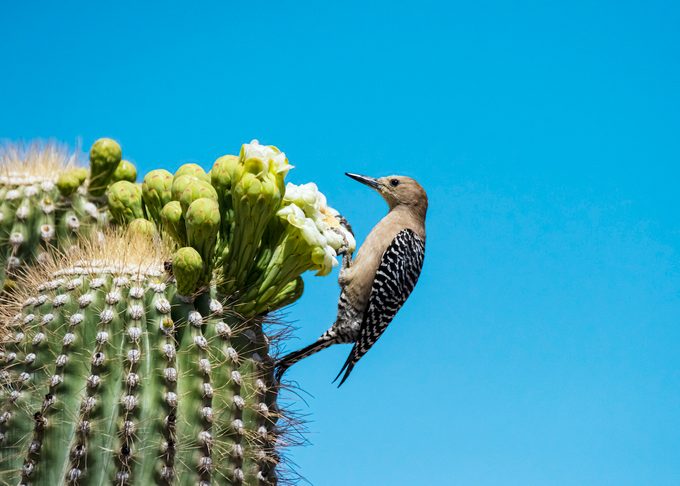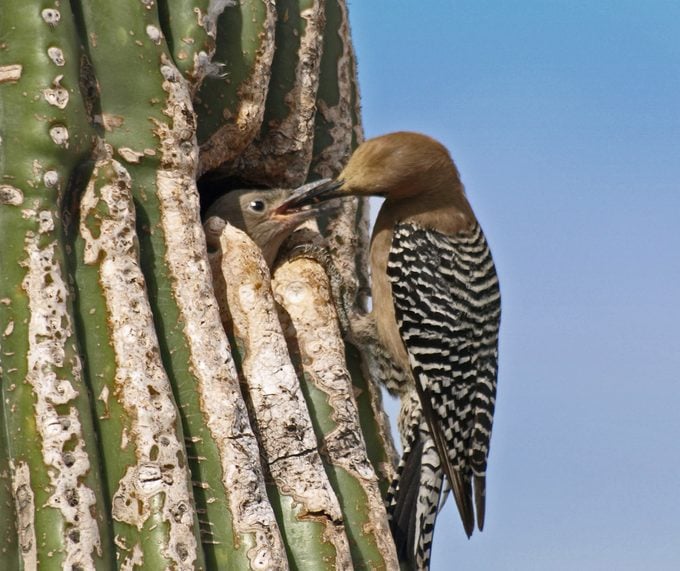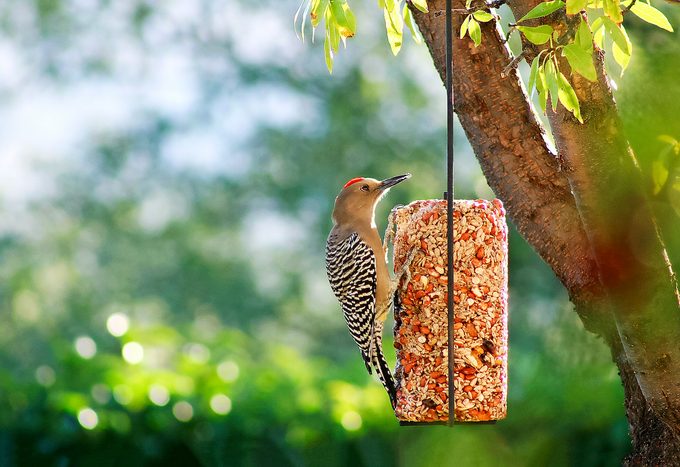Look for the Gila Woodpecker in the Desert
Updated: Sep. 29, 2023
Combining beauty, personality and a critical role in the desert ecosystem, Gila woodpeckers are fascinating birds to attract to the backyard.
What Does a Gila Woodpecker Look Like?

Sharing similar regions and a general appearance to the gilded flicker, one way to tell them apart is the Gila woodpecker lacks the red patch on its malar nape. Instead, the males sport a red patch on their crown. Both the males and females are grayish-brown on their head and body with black and white barred wings.
“They’re beautiful coloration.” said Emily Clark, Communications & Partnerships Specialist with the Sonoran Joint Venture in Tucson, Arizona, who also notes they have the personalities to match their striking appearance. “They’re busy bodies and super fun to watch.”
Meet more types of woodpeckers birders should know.
Gila Woodpecker Call and Sounds
Many people hear the Gila woodpeckers before they see them. “(Their call) is super loud. It will wake you up,” noted Clark. Vocalizations tend to be single notes, along with “piips or “churrs“, in a series. She pointed out that these are ideal calls to learn when identifying bird vocalizations because they’re easy to recognize. Males also often drum on homes and trees.
Boost your bird knowledge with mind-blowing woodpecker facts.
Range and Habitat
Most people picture woodpeckers hammering on trees, but for the Gila woodpecker, a desert inhabitant of the Southwest, saguaro cactus are their preferred residence.
They are seen in southeast California, southwest Nevada, southern Arizona, southwest New Mexico and well into Mexico. “They are very specialized to the Sonoran (Desert). They’re closely tied to the saguaro cactus,” said Clark who noted that the Gila woodpecker and gilded flicker, are both non-migratory species.
Red-Headed vs red-bellied woodpecker: what’s the difference?
Nesting Habits

The saguaro cactus is key to their lifecycle in this harsh region, providing a place to feed upon insects, as well as offering nesting areas. During the mating and nesting period, the males possessively protect their area, chasing off potential intruders until the young have fledged.
“They are primary cavity nesters meaning they’ll create the cavity,” explained Clark. “They pick away at the living flesh of the saguaro cactus. It takes a few months for the cavity to cure. It’s like creating scar tissue.”
This excavated area inside the cactus is called a boot. “It creates a wonderful nesting spot because it’s so much cooler in there,” she said. This allows them to raise three to four eggs at least once a season.
“(Their work) is central to our ecosystem because they provide cavities to our secondary cavity nesters. These include kestrels, elf owls, flycatchers and especially the desert purple martins, which have very specific nesting requirements that Gila woodpeckers provide,” said Clark.
But they are not relegated to only the desert. “The Gila woodpecker has adapted well to the urban environment,” said Clark. “You’ll see them nesting in neighborhoods.”
They are mated pairs for life, and share incubation duties, along with both feeding the young until shortly after they fledge. “They are very good, attentive parents,” Clark said.
What does a baby woodpecker look like?
How to Attract Gila Woodpeckers

Because they will nest in saguaros in peoples’ backyards, there is an opportunity to improve the odds of having them stay around. “Natural vegetation is so important to have,” she said.
Even though saguaro are preferred, they’ll also utilize cottonwoods, eucalyptus, willows, sycamore, and paloverde for nesting, and scour the trunks of trees or search among shrubs for insects and fruit. Planting native shrubs and perennials offers a greater chance of food sources.
“They’re opportunistic omnivores. They’ll eat a little bit of everything,” she said. Besides insects of all sizes, this includes fruits and seeds, lizards, and even the eggs of other birds allowing them to adapt well to the backyard setting.
“They’re pretty gregarious, and will come in to the suet feeders, and even use their long tongues on hummingbird feeders,” said Clark. There are even reports of Gila woodpeckers snacking on pet food.




















